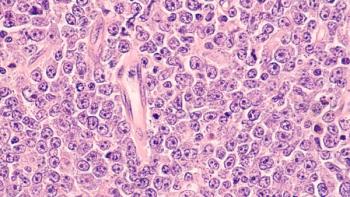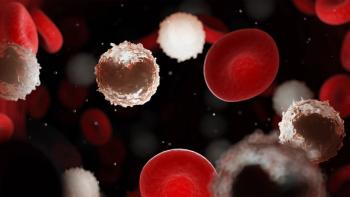
The FDA is Considering Granting Regular Approval to Mirvetuximab Soravtansine in FRα+ Platinum-Resistant Ovarian Cancer
The FDA has granted priority review to mirvetuximab soravtansine for folate receptor α (FRα)–positive, platinum-resistant epithelial ovarian, fallopian tube, or primary peritoneal cancer.
The FDA has launched a priority review of the supplemental biologics license application (sBLA) for mirvetuximab soravtansine -gynx (Elahere). The sBLA is seeking to convert the accelerate approval patients with folate receptor α (FRα)–positive, platinum-resistant epithelial ovarian, fallopian tube, or primary peritoneal cancer who previously received 1 to 3 lines of systemic treatment to full approval.1
The
The median PFS with mirvetuximab soravtansine (n = 227) was 5.62 months (95% CI, 4.34-5.95) by investigator assessment vs 3.98 months (95% CI, 2.86-4.47) with chemotherapy (n = 226), translating to a 35% reduction in the risk of disease progression or death (HR, 0.65; 95% CI, 0.52-0.81; P < .0001).3 The ADC elicited an investigator-assessed ORR of 42% (95% CI, 35.8%-49.0%) vs 16% (95% CI, 11.4%-21.4%) with chemotherapy, translating to a percentage difference of 26.4% (OR, 3.81; P < .0001). Moreover, the median OS with mirvetuximab soravtansine was 16.46 months (95% CI, 14.46-24.57) vs 12.75 months (95% CI, 10.91-14.36) with chemotherapy, translating to a 33% reduction in the risk of death (HR, 0.67; 95% CI, 0.50-0.89; P = .0046).
Under the Prescription Drug User Fee Act the regulatory agency will decide on the application by April 5, 2024.1
“With the FDA’s filing of our sBLA, we are one step closer to securing full approval of ELAHERE in the US and establishing this novel ADC as the standard of care in FRα-positive platinum-resistant ovarian cancer,” Michael Vasconcelles, MD, executive vice president of research, development, and medical affairs at ImmunoGen, Inc., stated in a press release.
Participants were randomly assigned 1:1 to receive mirvetuximab soravtansine at 6 mg/kg every 3 weeks or investigator’s choice of chemotherapy, which could have included paclitaxel, pegylated liposomal doxorubicin (PLD), or topotecan. They were stratified based on chemotherapy received and the number of prior lines of therapy received.
PFS by investigator assessment served as the trial’s primary end point. Important secondary end points included investigator-assessed ORR, OS, and patient-reported outcomes. Other end points of interest included duration of response, CA-125 response, time from randomization until second disease progression, and safety and tolerability.
The data cutoff date for the data presented during the
The median age of patients was 62.5 years (range, 29-88). Most patients in the ADC and chemotherapy arms had stage III disease at diagnosis (60% vs 65%), did not harbor a BRCA mutation or had unknown status (87% vs 84%), had a primary platinum-free interval (PFI) of 12 months or less (64% vs 63%), and a PFI of greater than 3 months but up to 6 months (61% vs 55%). In the ADC arm, 61% of patients previously received bevacizumab, 55% had prior PARP inhibitor exposure, and 100% received taxanes; in the chemotherapy arm, these rates were 63%, 56%, and 99%, respectively.
Moreover, in the mirvetuximab soravtansine arm, 14% of patients received 1 prior line of systemic treatment, 40% received 2 prior lines, and 46% received 3 prior lines; these rates were 14%, 40%, and 46%, respectively, in the chemotherapy arm. In the ADC arm, 41% of patients received paclitaxel, 36% received PLD, and 23% had topotecan; in the chemotherapy arm, these rates were 41%, 36%, and 23%, respectively.
The maximum percentage change in target lesion size from baseline with mirvetuximab was 80% per investigator assessment; with chemotherapy, the maximum percentage change was 55%.
BICR for PFS and ORR were concordant with investigator assessment. The median PFS by BICR with the ADC was 5.9 months (95% CI, 4.9-7.0) vs 4.3 months (95% CI, 3.5-5.0) with chemotherapy (HR, 0.72; 95% CI, 0.56-0.92; P = .0082). The ORR by BICR with the ADC was 36% (95% CI, 30%-43%) vs 15% (95% CI, 10%-20%) with chemotherapy (OR, 3.22; 95% CI, 2.04-5.09; P < .0001).
Any-grade treatment-emergent adverse effects (TEAEs) were reported in 96% of those in the mirvetuximab soravtansine arm vs 94% of those in the chemotherapy arm; these effects were grade 3 or higher for 42% and 54% of patients, respectively. Serious AEs occurred in 24% of those in the ADC arm and 33% of those in the chemotherapy arm. In the ADC arm, TEAEs led to reductions, delays, discontinuation, or death for 34%, 54%, 9%, and 2%, of patients, respectively; in the chemotherapy arm, these rates were 24%, 54%, 16%, and 2%, respectively.
The most common TEAEs experienced with mirvetuximab soravtansine included neutropenia (all grade, 11%; grade ≥3, <1%), anemia (10%; <1%), thrombocytopenia (7%; <1%), peripheral neuropathy (22%; 1%), alopecia (1%; 0%), diarrhea (29%; 1%), nausea (27%; 2%), stomatitis (3%; 0%), blurred vision (41%; 8%), keratopathy (32%; 9%), and dry eye (28%; 3%).
“This regulatory milestone, achieved just over one year after Elahere’s accelerated approval, underscores the significance of the confirmatory MIRASOL data and the broader data set seen to date with Elahere, as well as the urgency with which our teams worked to bring this potentially practice-changing therapy to eligible patients in need,” Vasconcelles added in the press release.1 “We look forward to collaborating closely with the FDA throughout the review process.”
In October 2023, the European Medicines Agency accepted a marketing authorization application seeking the approval of mirvetuximab soravtansine for use in this patient population.4 A new drug application seeking the approval of the agent has also been accepted by China’s National Medical Products Administration.1
References
- FDA grants priority review of ImmunoGen’s supplemental biologics license application for Elahere (mirvetuximab soravtansine-gynx) in platinum-resistant ovarian cancer. News release. ImmunoGen, Inc. December 5, 2023. Accessed December 5, 2023.
https://investor.immunogen.com/news-releases/news-release-details/fda-grants-priority-review-immunogens-supplemental-biologics - ImmunoGen announces FDA accelerated approval of Elahere (mirvetuximab soravtansine-gynx) for the treatment of platinum-resistant ovarian cancer. News release. ImmunoGen, Inc. November 14, 2022. Accessed December 5, 2023.
https://investor.immunogen.com/news-releases/news-release-details/immunogen-announces-fda-accelerated-approval-elaheretm - Moore KN, Angelergues A, Konecny GE, et al. Phase III MIRASOL (GOG 3045/ENGOT-ov55) study: mirvetuximab soravtansine vs. investigator’s choice of chemotherapy in platinum-resistant, advanced high-grade epithelial ovarian, primary peritoneal or fallopian tube cancers with high folate receptor-alpha (FRα) expression. J Clin Oncol. 2023;41(suppl 17):LBA5507.
- ImmunoGen announces European Medicines Agency Acceptance of marketing authorization application for mirvetuximab soravtansine in platinum-resistant ovarian cancer. News release. ImmunoGen, Inc. October 27, 2023. Accessed December 5, 2023.
https://investor.immunogen.com/news-releases/news-release-details/immunogen-announces-european-medicines-agency-acceptance
Newsletter
Knowledge is power. Don’t miss the most recent breakthroughs in cancer care.
















































































